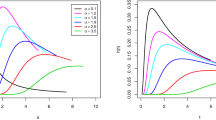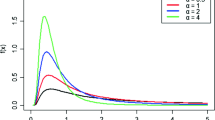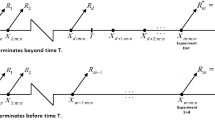Abstract
To reduce total test time and increase the efficiency of statistical analysis of a life-testing experiment adaptive progressive Type-II censoring scheme has been proposed. This paper addresses the statistical inference of the unknown parameters, reliability, and hazard rate functions of logistic exponential distribution under adaptive progressive Type-II censored samples. Maximum likelihood estimates (MLEs) and maximum product spacing estimates (MPSEs) for the model parameters, reliability, and hazard rate functions can not be obtained explicitly, hence these are derived numerically using the Newton–Raphson method. Bayes estimates for the unknown parameters and reliability and hazard rate functions are computed under squared error loss function (SELF) and linear exponential loss function (LLF). It has been observed that the Bayes estimates are not in explicit forms, hence an approximation method such as Markov Chain Monte Carlo (MCMC) method is employed. Further, asymptotic confidence intervals (ACIs) and highest posterior density (HPD) credible intervals for the unknown parameters, reliability, and hazard rate functions are constructed. Besides, point and interval Bayesian predictions have been derived for future samples. A Monte Carlo simulation study has been carried out to compare the performance of the proposed estimates. Furthermore, three different optimality criteria have been considered to obtain the optimal censoring plan. Two real-life data sets, one from electronic industry and other one from COVID-19 data set containing the daily death rate from France are re-analyzed to demonstrate the proposed methodology.












Similar content being viewed by others
Abbreviations
- AB:
-
Average bias
- ACI:
-
Asymptotic confidence interval
- AL:
-
Average length
- APC-II:
-
Adaptive progressive Type-II censoring
- ALT:
-
Accelerated life testing
- BCI:
-
Bayesian credible interval
- BPI:
-
Bayesian predictive interval
- CDF:
-
Cumulative distribution function
- CP:
-
Coverage probability
- HPD:
-
Highest posterior density
- K–S:
-
Kolmogorov–Smirnov
- LE:
-
Logistic exponential
- LF:
-
Likelihood function
- LLF:
-
Linear exponential loss function
- MCMC:
-
Markov chain Monte Carlo
- MLE:
-
Maximum likelihood estimation
- MPS:
-
Maximum product spacing
- MPSE:
-
Maximum product spacing estimation
- MH:
-
Metropolis–Hastings
- MSE:
-
Mean squared error
- N–R:
-
Newton–Raphson
- PDF:
-
Probability density function
- P–P:
-
Probability–probability
- PSF:
-
Product spacing function
- Q–Q:
-
Quantile–quantile
- SELF:
-
Squared error loss function
- VCM:
-
Variance–covariance matrix
References
Ahmed EA (2014) Bayesian estimation based on progressive Type-II censoring from two-parameter bathtub-shaped lifetime model: an Markov chain Monte Carlo approach. J Appl Stat 41(4):752–768
Ali S, Dey S, Tahir MH, Mansoor M (2020) Two-parameter logistic-exponential distribution: some new properties and estimation methods. Am J Math Manag Sci 1–29
Almarashi AM, Algarni A, Okasha H, Nassar M (2022) On reliability estimation of Nadarajah–Haghighi distribution under adaptive type-I progressive hybrid censoring scheme. Qual Reliab Eng Int 38(2):817–833
Almetwally EM, Almongy HM, ElSherpieny E (2019) Adaptive type-II progressive censoring schemes based on maximum product spacing with application of generalized Rayleigh distribution. J Data Sci 17(4):802–831
Alrumayh A, Weera W, Khogeer HA, Almetwally EM (2023) Optimal analysis of adaptive type II progressive censored for new unit-lindley model. J King Saud Univ Sci 35(2):102462
Ateya SF, Amein M, Mohammed HS (2022) Prediction under an adaptive progressive type-ii censoring scheme for Burr type-XII distribution. Commun Stat Theory Methods 51(12):4029–4041
Balakrishnan N, Childs A, Chandrasekar B (2002) An efficient computational method for moments of order statistics under progressive censoring. Stat Probab Lett 60(4):359–365
Balakrishnan N, Cramer E (2014) The art of progressive censoring. Stat Ind Technol
Basak I, Basak P, Balakrishnan N (2006) On some predictors of times to failure of censored items in progressively censored samples. Comput Stat Data Anal 50(5):1313–1337
Basu S, Singh SK, Singh U (2018) Bayesian inference using product of spacings function for progressive hybrid type-I censoring scheme. Statistics 52(2):345–363
Cheng R, Amin N (1983) Estimating parameters in continuous univariate distributions with a shifted origin. J R Stat Soc: Ser B (Methodol) 45(3):394–403
Dahmen K, Burkschat M, Cramer E (2012) A-and D-optimal progressive type-II censoring designs based on Fisher information. J Stat Comput Simul 82(6):879–905
Dey S, Elshahhat A (2022) Analysis of Wilson–Hilferty distribution under progressive type-II censoring. Qual Reliab Eng Int
Dey S, Elshahhat A, Nassar M (2022) Analysis of progressive type-II censored gamma distribution. Comput Stat 1–28
Dey T, Dey S, Kundu D (2016) On progressively type-II censored two-parameter Rayleigh distribution. Commun Stat Simul Comput 45(2):438–455
Dombi J, Jonas T, Toth ZE, Arva G (2019) The omega probability distribution and its applications in reliability theory. Qual Reliab Eng Int 35(2):600–626
Dutta S, Kayal S (2022) Estimation and prediction for Burr type III distribution based on unified progressive hybrid censoring scheme. J Appl Stat 1–33
Dutta S, Kayal S (2022) Estimation of parameters of the logistic exponential distribution under progressive type-I hybrid censored sample. Qual Technol Quant Manag 19(2):234–258
El-Sherpieny E-SA, Almetwally EM, Muhammed HZ (2020) Progressive type-II hybrid censored schemes based on maximum product spacing with application to Power Lomax distribution. Physica A 553:1242–51
Elshahhat A, Nassar M (2021) Bayesian survival analysis for adaptive type-II progressive hybrid censored Hjorth data. Comput Stat 36(3):1965–1990
Friendly M, Fox J, Chalmers P, Monette G, Sanchez G (2021) Package ‘matlib’. https://cran.microsoft.com/web/packages/matlib/matlib.pdf
Greene WH (2003) Econometric analysis. Pearson Education India, Noida
Hasselman B, Hasselman MB (2018) Package ‘nleqslv’. R package version 3(2)
Hastings WK (1970) Monte Carlo sampling methods using Markov chains and their applications. Biometrika 57(1):97–109
Hjorth U (1980) A reliability distribution with increasing, decreasing, constant and bathtub-shaped failure rates. Technometrics 22(1):99–107
Jha MK, Dey S, Alotaibi RM, Tripathi YM (2020) Reliability estimation of a multicomponent stress-strength model for unit Gompertz distribution under progressive type II censoring. Qual Reliab Eng Int 36(3):965–987
Kayal T, Tripathi YM, Singh DP, Rastogi MK (2017) Estimation and prediction for Chen distribution with bathtub shape under progressive censoring. J Stat Comput Simul 87(2):348–366
Kohansal A, Bakouch HS (2021) Estimation procedures for Kumaraswamy distribution parameters under adaptive type-II hybrid progressive censoring. Commun Stat Simul Comput 50(12):4059–4078
Kundu D (2008) Bayesian inference and life testing plan for the Weibull distribution in presence of progressive censoring. Technometrics 50(2):144–154
Kundu D, Pradhan B (2009) Estimating the parameters of the generalized exponential distribution in presence of hybrid censoring. Commun Stat Theory Methods 38(12):2030–2041
Kuş C (2007) A new lifetime distribution. Comput Stat Data Anal 51(9):4497–4509
Lan Y, Leemis LM (2008) The logistic-exponential survival distribution. Nav Res Logist 55(3):252–264
Mahto A, Dey S, Mani Tripathi Y (2020) Statistical inference on progressive-stress accelerated life testing for the logistic exponential distribution under progressive type-II censoring. Qual Reliab Eng Int 36(1):112–124
Maiti K, Kayal S (2021) Estimation of parameters and reliability characteristics for a generalized Rayleigh distribution under progressive type-II censored sample. Commun Stat Simul Comput 50(11):3669–3698
Metropolis N, Rosenbluth AW, Rosenbluth MN, Teller AH, Teller E (1953) Equation of state calculations by fast computing machines. J Chem Phys 21(6):1087–1092
Mohie El-Din M, Abu-Youssef S, Ali NS, Abd El-Raheem A (2017) Classical and Bayesian inference on progressive-stress accelerated life testing for the extension of the exponential distribution under progressive type-II censoring. Qual Reliab Eng Int 33(8):2483–2496
Mohie El-Din M, Shafay A, Nagy M (2018) Statistical inference under adaptive progressive censoring scheme. Comput Stat 33(1):31–74
Nassar M, Abo-Kasem O (2017) Estimation of the inverse Weibull parameters under adaptive type-II progressive hybrid censoring scheme. J Comput Appl Math 315:228–239
Nassar M, Abo-Kasem O, Zhang C, Dey S (2018) Analysis of Weibull distribution under adaptive type-II progressive hybrid censoring scheme. J Indian Soc Probab Stat 19(1):25–65
Ng HKT, Kundu D, Chan PS (2009) Statistical analysis of exponential lifetimes under an adaptive type-II progressive censoring scheme. Nav Res Logist (NRL) 56(8):687–698
Ng H, Luo L, Hu Y, Duan F (2012) Parameter estimation of three-parameter Weibull distribution based on progressively type-II censored samples. J Stat Comput Simul 82(11):1661–1678
Panahi H, Moradi N (2020) Estimation of the inverted exponentiated Rayleigh distribution based on adaptive Type II progressive hybrid censored sample. J Comput Appl Math 364:1123–45
Plummer M, Best N, Cowles K, Vines K (2015) Package ‘coda’. http://cran.r-project.org/web/packages/coda/coda.pdf. Accessed 25 January 2015
Pradhan B, Kundu D (2013) Inference and optimal censoring schemes for progressively censored Birnbaum–Saunders distribution. J Stat Plan Inference 143(6):1098–1108
Rastogi MK, Tripathi YM (2012) Estimating the parameters of a Burr distribution under progressive type II censoring. Stat Methodol 9(3):381–391
Rastogi MK, Tripathi YM, Wu S-J (2012) Estimating the parameters of a bathtub-shaped distribution under progressive type-II censoring. J Appl Stat 39(11):2389–2411
Saha M, Dey S, Maiti SS (2019) Bootstrap confidence intervals of \(C_{pTk}\) for two parameter logistic exponential distribution with applications. Int J Syst Assur Eng Manag 10(4):623–631
Shakhatreh MK, Lemonte AJ, Moreno-Arenas G (2019) The log-normal modified Weibull distribution and its reliability implications. Reliab Eng Syst Saf 188:6–22
Singh DP, Tripathi YM, Rastogi MK, Dabral N (2017) Estimation and prediction for a burr type-III distribution with progressive censoring. Commun Stat Theory Methods 46(19):9591–9613
Singh S, Arabi Belaghi R, Noori Asl M (2019) Estimation and prediction using classical and Bayesian approaches for Burr III model under progressive type-I hybrid censoring. Int J Syst Assur Eng Manag 10(4):746–764
Sirvanci M, Yang G (1984) Estimation of the Weibull parameters under type I censoring. J Am Stat Assoc 79(385):183–187
Valiollahi R, Raqab MZ, Asgharzadeh A, Alqallaf F (2018) Estimation and prediction for power Lindley distribution under progressively type II right censored samples. Math Comput Simul 149:32–47
Van Staden PJ, King RA (2016) Kurtosis of the logistic-exponential survival distribution. Commun Stat Theory Methods 45(23):6891–6899
Wang F (2000) A new model with bathtub-shaped failure rate using an additive Burr XII distribution. Reliab Eng Syst Saf 70(3):305–312
Wingo DR (1993) Maximum likelihood estimation of Burr XII distribution parameters under type II censoring. Microelectron Reliab 33(9):1251–1257
Wu S-J (2008) Estimation of the two-parameter bathtub-shaped lifetime distribution with progressive censoring. J Appl Stat 35(10):1139–1150
Ye Z-S, Chan P-S, Xie M, Ng HKT (2014) Statistical inference for the extreme value distribution under adaptive type-II progressive censoring schemes. J Stat Comput Simul 84(5):1099–1114
Acknowledgements
The authors would like to thank the Editor in Chief, an Associate Editor and two anonymous reviewers for their positive remarks and useful comments. The author S. Dutta, thanks the Council of Scientific and Industrial Research (C.S.I.R. Grant No. 09/983(0038)/2019-EMR-I), India, for the financial assistantship received to carry out this research work. The authors thank the research facilities received from the Department of Mathematics, National Institute of Technology Rourkela, India.
Author information
Authors and Affiliations
Corresponding author
Additional information
Publisher's Note
Springer Nature remains neutral with regard to jurisdictional claims in published maps and institutional affiliations.
Appendix 1
Appendix 1
1.1 Proof of Theorem 2.1
Equation (2.3) can be written as
We will show that for \((\alpha ,\lambda ) \in (0,\infty ) \times (0,\infty )\), the maximum of \(l(\alpha ,\lambda )\) exists and it is unique.
From Sect. 2.3, it has been observed that \(\frac{\partial ^2l}{\partial \alpha ^2}<0\) and \(\frac{\partial ^2l}{\partial \lambda ^2}<0\). Hence, for fixed \(\lambda (\alpha )\), \(l(\alpha ,\lambda |{\bf x})\) is strictly concave function of \(\alpha (\lambda )\). Moreover, for fixed \(\lambda\),
and for fixed \(\alpha\),
Therefore, for fixed \(\lambda (\alpha )\), \(l(\alpha ,\lambda |{\bf x})\) is unimodal function with respect to \(\alpha (\lambda )\). Furthermore,
Now, the rest of the proof follows from that of Theorem 1 of Dey et al. (2016) (see pp. 453–54). Thus, it is omitted. \(\square\)
Rights and permissions
Springer Nature or its licensor (e.g. a society or other partner) holds exclusive rights to this article under a publishing agreement with the author(s) or other rightsholder(s); author self-archiving of the accepted manuscript version of this article is solely governed by the terms of such publishing agreement and applicable law.
About this article
Cite this article
Dutta, S., Dey, S. & Kayal, S. Bayesian survival analysis of logistic exponential distribution for adaptive progressive Type-II censored data. Comput Stat (2023). https://doi.org/10.1007/s00180-023-01376-y
Received:
Accepted:
Published:
DOI: https://doi.org/10.1007/s00180-023-01376-y




